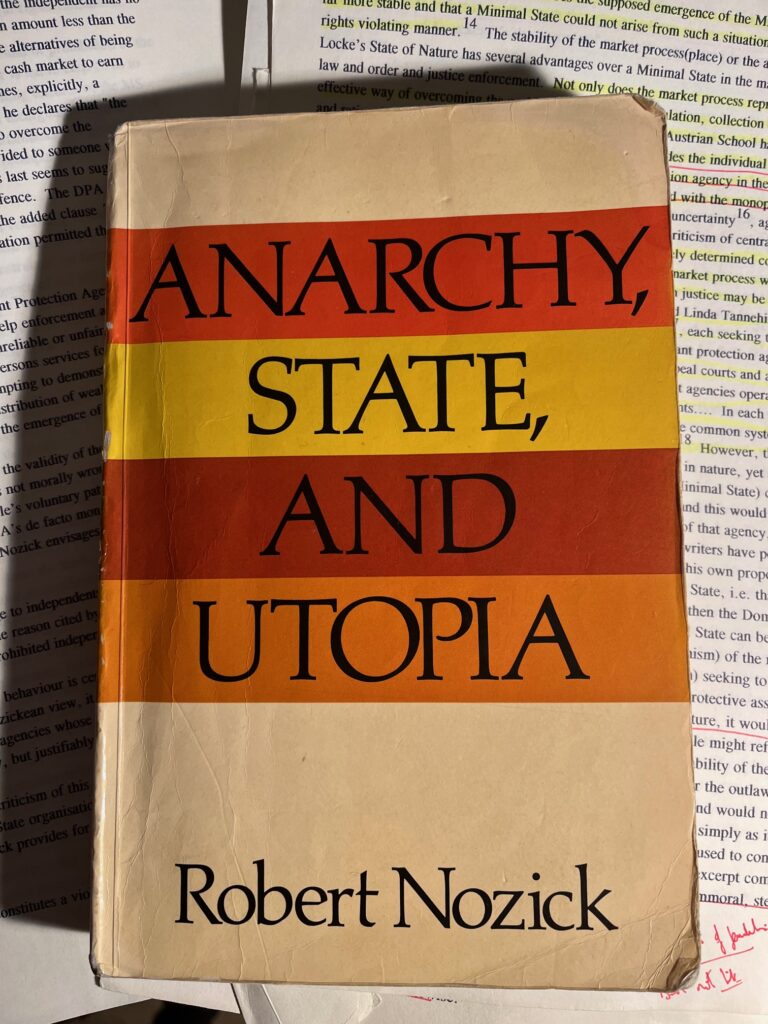Robert Nozick’s Anarchy, State, and Utopia — at 50
Fifty years ago, Robert Nozick opened his most famous work, Anarchy, State, and Utopia (ASU), with the following words:
“Individuals have rights, and there are things no person or group may do to them (without violating their rights). So strong and far-reaching are these rights that they raise the question of what, if anything, the state and its officials may do. How much room do individual rights leave for the state?”
Nozick’s book was quickly juxtaposed to John Rawls’ earlier, A Theory Of Justice (1971). Indeed, I first read ASU in Dr John Horton’s class on “Theories of Justice” alongside Rawls, which I took in 1989 during my second year of undergraduate Economics at the University of York. Yet the two books are very different, both in their philosophical approach and in their reception and continuing influence.

Rawls has significantly shaped the political philosophy landscape: a huge body of scholarship exists that responds to or extends his approach; not so for Nozick. To be sure, Nozick’s arguments have prompted some fine scholarship over the years but nowhere near the same scale as that enjoyed by Rawls. In part, I suspect it’s because Nozick fails to ground his theory of rights, choosing to sidestep the origin of rights by asserting their existence (as above), and then exploring the implications of those rights. The other main reason, I believe, for Rawls eclipsing Nozick is ASU’s audience.
In Part 1 of ASU, Nozick seeks to address the extreme libertarianism or anarcho-capitalism of David Friedman, in his The Machinery of Freedom (1973), and Murray Rothbard, in Power and Market (1970). Nozick wants to establish both a justification for and a story explaining the existence of a (very limited) Minimal State. In Part 2, Nozick argues against efforts to expand his Minimal State beyond security provision, such as through welfare provision. In the very short Part 3, Nozick explores why his conception of a very limited Minimal State might/should still inspire: for it creates a ‘Framework for Utopia’ that enables so many different visions of the good life to be realised alongside one another. During the 1989 summer vacation, immediately before I took the “Theories of Justice” class, I participated in one of the Institute for Humane Studies’ “Liberty and Society” residential seminars. As a consequence, Part 1 was the most interesting section of ASU and I explored its arguments at length when I wrote my class assessment paper. Over the intervening years, my thoughts have increasingly focused on Part 3, and the role of utopian thought.
Nozick’s central argument in Part 1 of ASU, is that order will emerge from chaos without central direction. Starting from a Lockean state of nature, Nozick tries to describe how we can arrive at a Minimal State without either rights violations or through a social contract. (Despite such actual social contracts like the Mayflower Compact of 1620, social contractarianism is more a thought experiment to establish what agents could (not) give up to form a state and, thus, what are the limits to its powers.)
Nozick’s “invisible hand” approach to the emergence of the Minimal State is worth reading, and sits well with a market process understanding of the social order. Within the state of nature, each of us can enforce our rights but there would be specialisation for the protection of rights just as there would be specialisation for farming or manufacturing. Private protection agencies would emerge. Nozick envisages a “Dominant Protection Agency” (DPA) emerging within the market for protective services.
The transition of the DPA to the Minimal State then occurs in two steps. First, the DPA acts to stop other smaller agencies or individual agents from enforcing rights claims against the DPA’s customers. Even if those rights claims are justified, Nozick asserts that the DPA would likely to view those claims (and the justice processes that generated them) with suspicion and would, therefore, act to protect its clients from having (even justified/correct) claims enforced against them. This transitions the DPA into the Ultra-Minimal State (UMS). The second step is that the UMS, by prohibiting smaller rival protection agencies from enforcing justified rights claims against its clients, owes compensation to those rival agencies. By compensating or redistributing protection services to those rivals and their customers, the UMS finally transitions into the Minimal State.
Much has been written about the problems with this two-stage process; and many more critiques will no doubt appear through the course of ASU’s 50th anniversary year. Rothbard memorably titled his, “Robert Nozick and the Immaculate Conception of the State” [Journal of Libertarian Studies 1 (Winter 1977): 45–57]. The most important single collection is the long out of print, Reading Nozick: Essays on Anarchy, State, and Utopia (1982), edited by Jeffrey Paul. For me, Nozick’s effort to provide a spontaneous order explanation for the emergence and legitimacy of the state simply ends up amputating the invisible hand.
This 50th anniversary year of Anarchy, State, and Utopia, I plan to dust off my old papers on Nozick’s theory of the state, and of utopia, and to integrate them into my current research work and to post some more short notes on Nozick’s thought and influence.